| Pilot Charles Mortimer Hall and Crew – 462 Squadron RAAF Middle East |
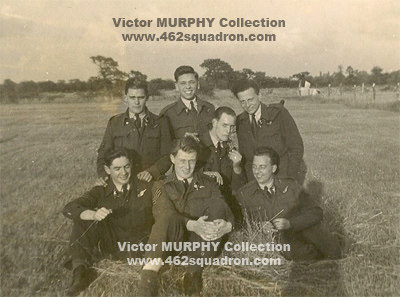
Photo from the Victor MURPHY Collection
C M HALL’s crew, 1658 HCU, Riccall, Yorkshire, July 1943.
Front left to right: Victor MURPHY (mid-upper gunner); Charles HALL (pilot); Harry WILD (navigator).
Middle: Ray ‘George’ WARD (wireless operator).
Rear: William ‘Taff’ NICHOLLS or NICHOLAS (bomb-aimer); Pat TALL (flight engineer); Phil WILLIAMS (tail gunner).
|
This crew served with 462 Squadron in the Middle East, from early November 1943, until the end of February 1944. They flew on Ops from Terria (Nov/Dec 1943) and El Adem (Jan/Feb 1944).
The permanent members of this crew were
Pilot: Charles Mortimer HALL 1349894 RAFVR
Navigator: Harry WILD 935265 RAFVR
Bomb Aimer: William M NICHOLAS 1423488 RAFVR
Wireless Operator: Raymond Gordon WARD 1576802 RAFVR
Flight Engineer: Patrick S TALL ------- RAFVR
Rear Gunner: Victor MURPHY 422056 RAAF
Other members of Crew (former or substitute)
Links to photos at Rabat, Terria, El Adem, Celone, Brindisi;
photos in later years; Additional Crew Information
including FlyPast magazine article "From Out of the Skies" for W/Op WARD; Wartime Recollections by R/AG MURPHY;and Trove article "AUSSIE AIRMEN AID TITO" also R/AG MURPHY; Crew Ops at 462 Squadron;
Honours and Awards.
The RAAF Service File for MURPHY, the only Australian in the crew, has been digitised, and data included in the additional crew information. Service information for WARD was summarised from FlyPast magazine.
Reference sources – Australian WW2 Nominal Roll; NAA (National Archives of Australia for RAAF A9301 Service File, 462 Squadron Operational Record Books, Personnel Occurrence Reports); TNA (National Archives UK); London Gazette; Air Force Lists; and other resources as noted in the text.
|
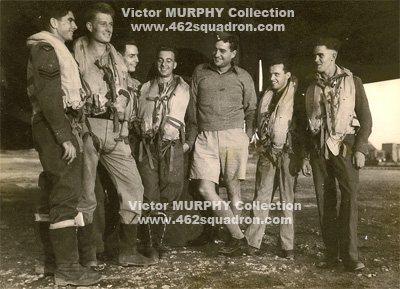
Photo from the Victor MURPHY Collection
Photo of Charles M. Hall’s crew probably taken at 148 Squadron, Brindisi, Italy (original caption “sometime after the 5th August 1944”).
Left to right: Victor MURPHY, (rear-gunner), Charles HALL (pilot), Ray ‘George’ WARD (wireless operator), Harry WILD (navigator/observer), Wing-Commander (original photo says Cdr) D G HAYWARD (Officer Commanding 148 Sqn), Jim LEEMING (flight engineer), William ‘Taff’ NICHOLLS (sic, bomb-aimer).
Note – Crew was posted to 148 Sqdn on 30 July 1944; MURPHY shows the rank of Flight Sergeant, and was promoted to Warrant officer on 04 Aug 1944; their first Op was on 05 Aug 1944.
From the 148 Squadron ORB, Form 540 – HAYWARD was posted to 148 Squadron at the rank of Squadron Leader (from 614 Squadron) on 22 August 1944, assumed command on 28 August; and was promoted to Acting Wing Commander on 28 August 1944. He was posted from 148 Sqdn on 21 March 1945. However HAYWARD had previously been flying Ops at 614 Squadron while the HALL crew were also at 614 Squadron, and on at least one occasion, both HAYWARD’s and HALL’s crews were on the same Op.
|
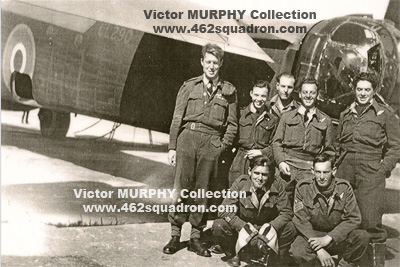
Photo from the Victor MURPHY Collection
Halifax LL290 and crew
Standing left to right: Charles HALL (pilot), Jim LEEMING (flight engineer), Harry WILD (navigator/observer), Victor MURPHY (rear-gunner).
Standing at rear: Ray ‘George’ WARD (wireless operator).
Front, squatting: left – W/O William ‘Taff’ NICHOLAS (bomb-aimer), and right – F/Sgt Philip Henry SMALL 427863 RNZAF.
The HALL crew can be matched with those already identified in crew photos (left and above). F/Sgt SMALL’s RNZAF Service summary may be seen on the Auckland War Memorial Online Cenotaph, along with a portrait photo which matches the face shown above.
FlyPast magazine article – Mentions last Op on 02 April 1945 – in Halifax LL920 in error. However from MURPHY’s Log book (shown in later section), Halifax was LL290; and from the April 45 ORB Form 541 for 148 Sq (from TNA/UK) – it was definitely LL290 "N" with crew on 02 April 1944 named as P/O HALL, W/O NICHOLAS, P/O WILD; W/O WARD, F/SGT LEEMING, W/O MURPHY and F/SGT SMALL.
Return to top
|
Pilot
Name: Charles Mortimer HALL (Charlie)
Service: Royal Air Force Volunteer Reserve
Service Number: 1349894 (later 189697)
Date and Place of Birth: .....
Date and Place of Enlistment: ..... *
Next of Kin: .....
Posting from 462 Squadron: March 1944
Rank at Posting from 462 Squadron: ....
Posting at Discharge: .....
Prisoner of War: No
* From the website http://www.ab-ix.co.uk/rfc_raf.pdf which details
RFC and RAF Service Numbers: No. 1340001 to No. 1350000 were allocated from Feb 1941 at Edinburgh. This batch includes 1349894 for HALL.
Return to top |
Navigator
Name: Harry WILD
Service: Royal Air Force Volunteer Reserve
Service Number: 935265 (later 190063)
Date and Place of Birth: .....
Date and Place of Enlistment: ..... *
Next of Kin: .....
Posting from 462 Squadron: March 1944
Rank at Posting from 462 Squadron:
Posting at Discharge: .....
Prisoner of War: No
* From the website http://www.ab-ix.co.uk/rfc_raf.pdf which details
RFC and RAF Service Numbers: No. 935000 to No. 964999 were allocated from Sep 1939 at Cardington. This batch includes 935265 for WILD.
Return to top |
Bomb Aimer
Name: William M NICHOLAS (Taff)
Service: Royal Air Force Volunteer Reserve
Service Number: 1423488
Date and Place of Birth: .....
Date and Place of Enlistment: ..... *
Next of Kin: .....
Posting from 462 Squadron: March 1944
Rank at Posting from 462 Squadron: ...
Posting at Discharge: .....
Prisoner of War: No
* From the website http://www.ab-ix.co.uk/rfc_raf.pdf which details
RFC and RAF Service Numbers: No. 1400001 to No. 1424800 were allocated from Mar 1941 at Penarth. This batch includes 1423488 for NICHOLAS.
Return to top
|
Wireless Operator
Name: Raymond Gordon WARD (George)
Service: Royal Air Force Volunteer Reserve
Service Number: 1576802
Date and Place of Birth: .....
Date and Place of Enlistment: ..... *
Next of Kin: .....
Posting from 462 Squadron: March 1944
Rank at Posting from 462 Squadron: ....
Posting at Discharge: .....
Prisoner of War: No
* From the website http://www.ab-ix.co.uk/rfc_raf.pdf which details
RFC and RAF Service Numbers: No. 1575001 to No. 1585000 were allocated from Jun 1941 at Birmingham. This batch includes 1576902 for WARD.
Return to top |
Flight Engineer
Name: Patrick S TALL (Pat)
Service: Royal Air Force Volunteer Reserve
Service Number: ..... (unknown)
Date and Place of Birth: .....
Date and Place of Enlistment: ..... *
Next of Kin: .....
Posting from 462 Squadron: March 1944
Rank at Posting from 462 Squadron:
Posting at Discharge: .....
Prisoner of War: No
* From the website http://www.ab-ix.co.uk/rfc_raf.pdf which details
RFC and RAF Service Numbers: No. ....... to No. .......... were allocated from .......... at ........ This batch includes ...... for ....... (service number not yet known).
Return to top |
Rear Gunner
Name: Victor MURPHY (Vic)
Service: Royal Australian Air Force
Service Number: 422056
Date of Birth: 25 November 1923
Place of Birth: Griffith, New South Wales
Date of Enlistment: 24 April 1942
Place of Enlistment: Sydney, NSW
Next of Kin: Ernest MURPHY
Date of Discharge: 18 September 1945
Rank at Discharge: Warrant Officer
Posting at Discharge: 21 Personnel Transit Centre
Prisoner of War: No
|
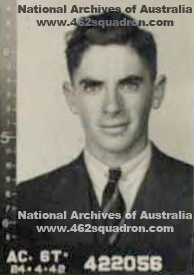
From the National Archives of Australia: A9301, 422056
Victor Murphy 422056 RAAF at enlistment, 24 April 1942.
|
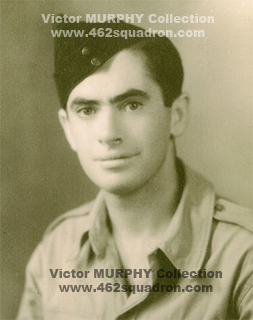
Photo from the Victor MURPHY Collection
Victor Murphy 422056 RAAF, MURPHY in ‘summer’ uniform, undated, rank not visible, location not known.
Return to top |
Flight Engineer – replacement
Name: Jim LEEMING
Service: Royal Air Force Volunteer Reserve
Service Number: .....
Date and Place of Birth: .....
Date and Place of Enlistment: ..... *
Next of Kin: .....
Posting from 462 Squadron: March 1944
Rank at Posting from 462 Squadron: .....
Posting at Discharge: .....
Prisoner of War: No
* From the website http://www.ab-ix.co.uk/rfc_raf.pdf which details
RFC and RAF Service Numbers: No. ....... to No. .......... were allocated from .......... at ........ This batch includes ...... for ...... (service number not yet known).
|
Original Rear Gunner
(with crew at OTU and HCU, recalled, and posted elsewhere)
Name: Phil WILLIAMS
Service: Royal Air Force Volunteer Reserve
Service Number: .....
Date and Place of Birth: .....
Date and Place of Enlistment: ..... *
Next of Kin: .....
Not Posted to 462 Squadron
No other information
* From the website http://www.ab-ix.co.uk/rfc_raf.pdf which details
RFC and RAF Service Numbers: No. ....... to No. .......... were allocated from .......... at ........ This batch includes ...... for ...... (service number not yet known).
Return to top |
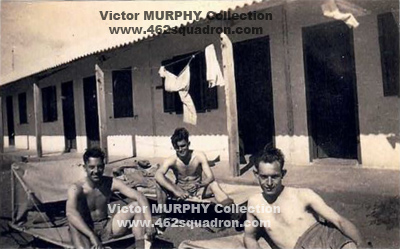
Photo from the Victor MURPHY Collection
Rabat, Morocco, Nov 1943, in transit from UK to Middle East.
Left to right – Harry WILD (Nav); William “Taff” NICHOLLAS (sic, bomb aimer), R G WARD (wireless operator)
|
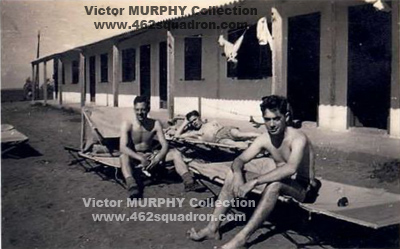
Photo from the Victor MURPHY Collection
Rabat, Morocco, Nov 1943, in transit from UK to Middle East.
Left to right – Harry WILD (Nav); William “Taff” NICHOLLAS (sic, bomb aimer), Vic MURPHY (rear gunner)
Return to top
|
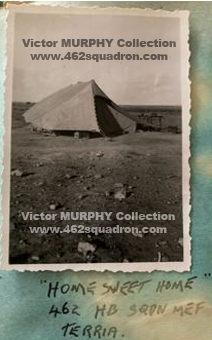
Photo from the Victor MURPHY Collection
"Home Sweet Home" – 462 Squadron, Terria, Cyrenaica (Libya), November/December 1943
|
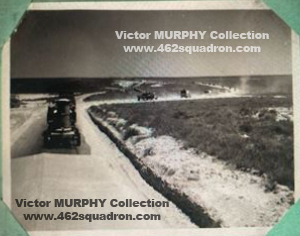
Photo from the Victor MURPHY Collection
Terria to El Adem convoy – 462 Squadron relocating from Terria to El Adem, Cyrenaica (Libya), January 1944
Return to top |
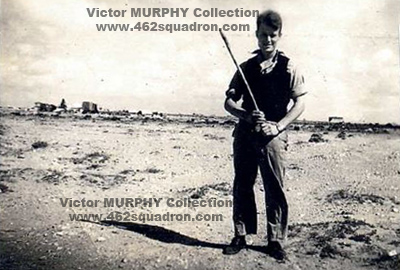
Photo from the Victor MURPHY Collection
462 Squadron, El Adem, near Tobruk, Cyrenaica (Libya) – Pilot Charlie HALL. By coincidence, he is wearing the same/similar clothes, and using the similar small crowbar in Celone.
|
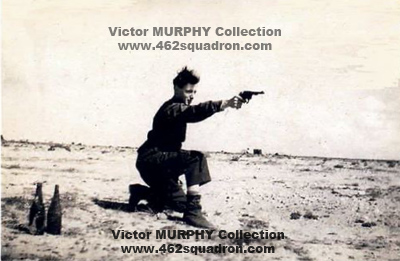
Photo from the Victor MURPHY Collection
462 Squadron, El Adem – Flight Engineer Bill McKAY, from another Crew, firing rounds at bottles.
Refer to the MURPHY Memoir for more on the handguns, and McKAY (Pilot ATWELL and crew, including McKAY, were all KIA on an Op from 614 Squadron. That crew had previously been posted to 462 Squadron in January 1944 at El Adem, but did not fly any ops before relocating with 462 Squadron to Italy).
|
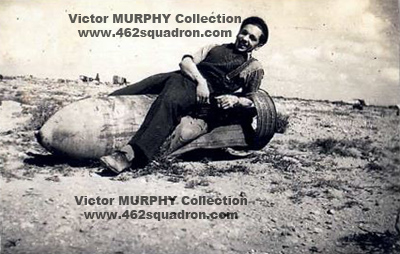
Photo from the Victor MURPHY Collection
462 Squadron, El Adem – Flight Engineer Pat TALL, reclining on an un-exploded bomb.
|
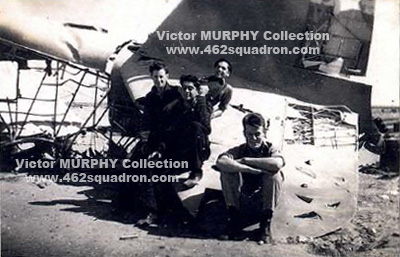
Photo from the Victor MURPHY Collection
462 Squadron, El Adem –
Left to right – Bill McKAY (Flight Engineer from ATWELL Crew); Vic MURPHY (Rear Gunner); Pat TALL (Flight Engineer) leaning backwards; and Charlie HALL (Pilot) alongside a crashed JU52.
Return to top
|
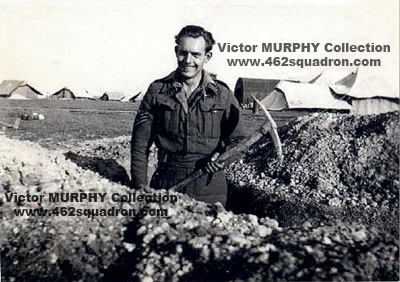
Photo from the Victor MURPHY Collection
Celone, Italy, 614 Squadron, 'George' WARD (Wireless Operator)
|
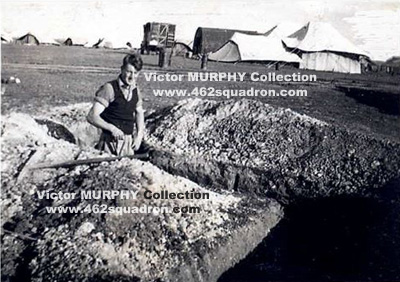
Photo from the Victor MURPHY Collection
Celone, Italy, 614 Squadron, Charlie HALL (Pilot)
By coincidence, he is wearing the same/similar clothes, and carrying the similar small crowbar in an El Adem photo. It seems that they had to dig their own trenches, but what for – latrines? Or for safety in the event of attack of the base by enemy aircraft?
Return to top
|
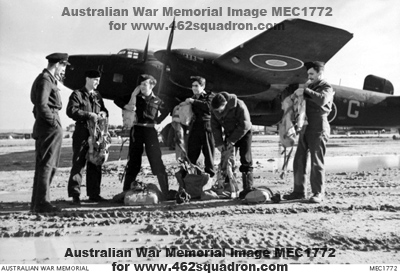
Image MEC1772 from the Australian War Memorial
MEC1772 AWM Made-up Crew including Warrant Officer Victor Murphy 422056 RAAF, late 1944.
Italy, late 1944. RAAF crew of an RAF Halifax squadron don their flying equipment and parachutes before taking off on a supply dropping mission to Tito's Partisan forces in Yugoslavia. Left to right: 410964 F/O R Eisenhauer of Albury, NSW; 430073 F/O H Walker of Mitcham, Vic; 432179 F/Sgt W Hodgins of Singleton, NSW; 422056 W/O V Murphy of Griffith, NSW; 424009 W/O L Shannon of Sydney, NSW; 432241 F/O Henry Oscar Mason of Sydney, NSW.
|
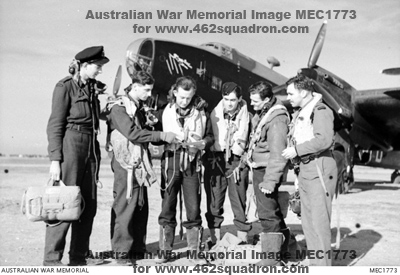
Image MEC1773 from the Australian War Memorial
MEC1773 AWM Made-up Crew including Warrant Officer Victor Murphy 422056 RAAF, late 1944.
Italy, late 1944. Group portrait of RAAF crew members an RAF Halifax squadron studying the route they are to fly on a supply dropping mission to Yugoslavia. Left to right: 410964 F/O R Eisenhauer of Albury, NSW; 430073 F/O Howard MacDonald Walker of Mitcham, Vic; 432179 F/Sgt W Hodgins of Singleton, NSW; 422056 W/O V Murphy of Griffith, NSW; 424009 W/O L Shannon of Sydney, NSW; 432241 F/O Henry Oscar Mason of Sydney, NSW.
|
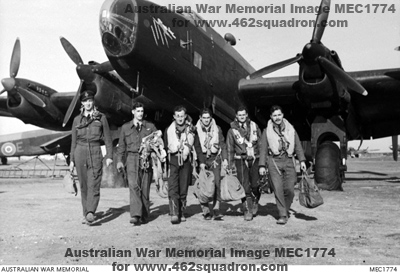
Image MEC1774 from the Australian War Memorial
MEC1774 AWM Made-up Crew including Warrant Officer Victor Murphy 422056 RAAF, late 1944.
Italy, late 1944. Group portrait of RAAF crew members in front of the Handley Page Halifax aircraft they are to fly on a supply dropping mission to Yugoslavia. Left to right: 410964 F/O R Eisenhauer of Albury, NSW; 420073 F/O H Walker of Mitcham, Vic; 432179 F/Sgt W Hodgins of Singleton, NSW; 422056 W/O V Murphy of Griffith, NSW; 424009 W/O L Shannon of Sydney, NSW; 432241 F/O O Mason of Sydney, NSW.
|
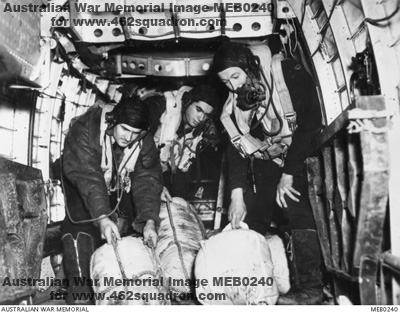
Image MEB0240 from the Australian War Memorial
MEB0240 AWM Made-up Crew including Warrant Officer Victor Murphy 422056 RAAF, late 1944.
Inside their aircraft, 424009 W/O L Shannon of Sydney, NSW; 422056 W/O V Murphy of Griffith, NSW; and 432179 F/Sgt W Hodgins of Singleton, NSW, prepare to drop supplies over Yugoslavia.
Return to top
|
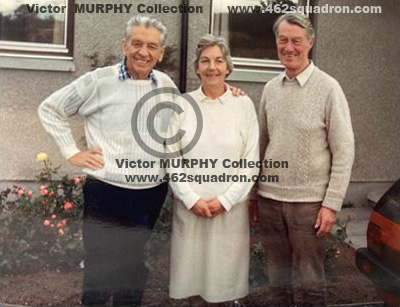
Photo from the Victor MURPHY Collection
Pat TALL (left) with Sheena and Charles HALL (right) photographed in 1990, three months before Pat died.
|
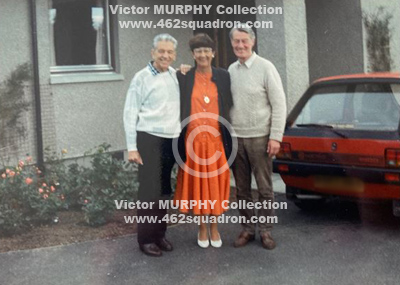
Photo from the Victor MURPHY Collection
Pat and Lisa TALL (left) with Charles HALL (right), in the UK, 1990.
|
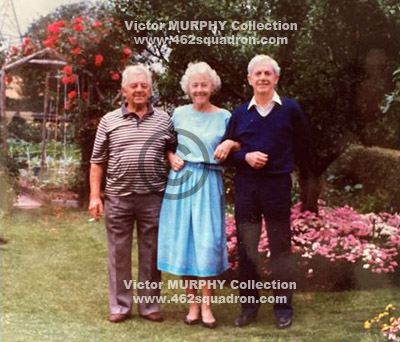
Photo from the Victor MURPHY Collection
Harry WILD (left) with Theresa and Victor MURPHY (right) Harry’s beautiful home garden, UK, 1990.
|
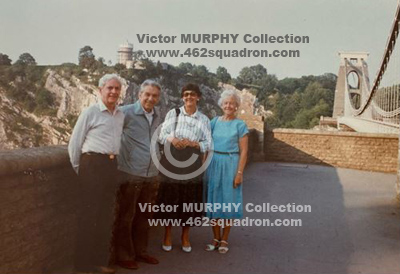
Photo from the Victor MURPHY Collection
Vic MURPHY (left) and Theresa MURPHY (right) with Pat and Lisa TALL (centre) in the UK, 1990.
|
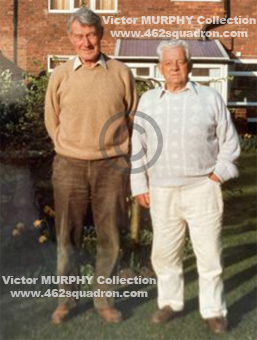
Photo from the Victor MURPHY Collection
|
Photo at left:
Charles HALL (left) and Harry WILD (right) photographed in the UK in 1997
Return to top
|
|
|
Additional Crew Information
RAAF A9301 Service File and WW2 Nominal Roll readily available for MURPHY.
Identification for RAFVR crew members was difficult.
Service Files not available for the RAFVR members of Crew.
For information, the following sources were checked – RAF Lists, London Gazette, and CWGC (all survived the War)
Ancestry and Findmypast, including the 1939 Register, were also checked, but due to insufficient knowledge, was unable to match the many results.
462 Squadron ORB Form 540 ORB, Dec 1943 – AIR 27/1916/31 – only Officers listed in Postings TO 462; therefore this crew was not mentioned because they were not Officers.
Personnel Occurrence Report from Jul 43 to Feb 44 – only RAAF personnel listed (MURPHY)
Service numbers were not listed in 462 Sqdn Ops; but some were listed in Ops for 614 Squadron from mid-May 1944.
614 Sqdn – only officers listed in Postings to the squadron (so this crew was not listed)
614 Sqdn – Sce Numbers only appeared from mid-May 1944 Ops
Crew identified as
Pilot 1349894 W/O C M HALL – Charlie, Scottish
Nav 935265 F/S H WILD – Harry, Yorkshire, only married member of crew
WOP 1576802 Sgt R G WARD – George, Leicestershire
T/Gnr A422056 F/S V MURPHY – the only Aus, previously MU/AG to end of HCU Training
Bdr 1423488 F/S W M NICHOLS – Taff, Welsh; surname error for NICHOLAS, also recorded as NICHOLLAS and NICHOLLS – checked NOT located in London Gazette by name variations or number.
Previous Gunner Phil WILLIAMS – from London, recalled during leave, so was not posted to 462 Squadron.
F/Eng P S TALL no record of Service Number – Pat, from London, had flashy smile (which is obvious in the photos)
ALL RAF/RAFVR, except MURPHY (RAAF)
Pilot: Charles Mortimer HALL 1349894 RAFVR
462 Sqdn – Posted in as Sgt; Posted out as F/Sgt
PILOT HALL, C M 189697 Index in RAF List 7/1945 – Flying Officer 04/03/45
Thence to London Gazette to locate Commission, promotions and Award of DFC.
London Gazette 36935 – RAFVR; W/O 1349894 Charles Mortimer HALL commissioned to rank of P/O 189697, 04 Sept 1944
London Gazette 36954
– RAFVR; W/O 1349894 Charles Mortimer HALL, 148 Squadron, award of DFC, 23 Feb 1945
London Gazette 37083 – RAFVR; P/O C M HALL, DFC, 189697 to F/O, 04 Mar 1945
148 Squadron – 28 Nov 1944 – W/Cdr D G HAYWARD in formation of a/c on flight to Tirana (capital of Albania) in celebration of partisans entering the town; and “shot-up” the town for 15 m; food drop diverted due to density of people in streets; after food drop nearby – W/Cdr flew over the area and released a huge Union Jack, the formation returned to base.
28 Nov 1944 – W/O C M HALL and crew in Halifax LL468-N – one of 6 crew to Tirana, with W/Cdr HAYWARD (15 containers and 15 packages dropped); flight 0745 to 1010 hrs
[CREW – W/O C M HALL; F/S W M NICHOLAS; W/O H WILD; F/S R G WARD (NAMED AS F/S R G WILD); SGT J LEEMING; F/S V MURPHY (AUS); F/S A D MERALDI]
30 Nov 1944 – Msg from Tirana re Ops on 28 Nov 1944 “Splendid impression created. No praise too high for crews. Many thanks.”
See also Honours and Awards for HALL in later section.
Return to top
Navigator: Harry WILD 935265 RAFVR
935265 W/O WILD appointed to Commission as P/O wef 25 Oct 1944 at 148 Squadron.
London Gazette 36957 – RAFVR; W/O 935265 Harry WILD commissioned to rank of P/O 190063, 26 Oct 1944
London Gazette 37104 – RAFVR; P/O Harry WILD 190063 to F/O, 26 Apr 1945
Return to top
Bomb Aimer: William M NICHOLAS 1423488 RAFVR
462 Sqdn – rank of Sgt
614 Sqdn – rank of F/Sgt
name errors – listed as NICHOLS, NICHOLLS, NICHOLLAS and NICHOLAS
Not located by the various name or number in London Gazette
Not located in RAF Lists as Warrant Officer
Return to top
Wireless Operator: Raymond Gordon WARD 1576802 RAFVR – 'George'
462 Sqdn – Posted To and from the squadron as Sgt
614 Sqdn – listed as F/Sgt
Not located in London Gazette by name & number; or in Air Force Lists
The following RAFVR Service has been summarised from previously published information in FlyPast ..........
“From Out of the Skies” researched and written by Roy BONSER, FlyPast issue April 2007, pages 31-38 inclusive, published by Key Publishing Ltd, UK. Email permission to use Article was given by Steve BEEBEE, Deputy Editor, on 31 Aug 2023 – https://www.key.aero/flypast – Thank you Steve and Roy.
Does anyone have the original magazine, and can provide a colour scan? If so. please contact.
Link to black and white scan copy of complete original Article with numerous photos .....
..... Flypast_Apr2007_WARD_and_Crew_exMURPHY_web.pdf .....
RAFVR Service Summary for Ray “George” WARD – Wireless Operator / Air Gunner
28 March 1923 – Raymond Gordon WARD born in Peckleton, Leicestershire
15 Jul 1941 – Volunteered to join RAF
16 Jul 1941 – Recommended by Aircrew Selection Board at Birmingham, for training as Wireless Operator
11 Nov 1941 – Called up, reported to 3 Recruit Centre for initial training
Undated – posted to 10 (Signals) Recruit Centre
Undated – posted to 2 Signals School, Yatesbury, Wiltshire, for technical training
04 Jun 1942 – Posted to 2 Heavy Mobile Unit
Undated Aug 1942 – Posted to 140 Squadron, Mount Farm, Oxfordshire
29 Oct 1942 – Posted to 4 Signals School, Madley, Herefordshire, for aircrew training as wireless operator / air gunner
Undated 1942 – Posted to 10 Air Gunnery School, Barrow-in-Furness, Cumbria, for gunnery training
Undated 1943 – Posted to 10 Operational Training Unit, Stanton Harcourt, for crew formation and operational training; crewed up with Pilot Sergeant Charles M HALL (Charlie); Navigator Harry WILD; Bomb Aimer William “Taff” NICHOLAS; Rear Gunner Phil WILLIAMS; Mid-Upper Gunner Vic MURPHY, the only Australian in the Crew. At 10 O T U, Raymond Gordon WARD became known to the crew as ‘George’. (MURPHY’s Service File, Posting dated as early May 1943)
12 Apr 1943 – first flying instruction at 10 O T U, in “B” Flight
10 Jun 1943 – final flight test at 10 O T U
Undated 1943 – Posted to 1658 Heavy Conversion Unit, Riccall, Yorkshire, training in four-engine Handley Page Halifax aircraft; addition to crew was Flight Engineer Pat TALL, from Bristol. (MURPHY’s Service File, Posting dated as 24 Jun 1943)
Loss of Crew’s original Rear Gunner Phil WILLIAMS, who was re-called for posting elsewhere. Vic MURPHY then became the crew’s rear gunner. (On 462 Squadron aircraft, the mid-upper turrets had been removed, making mid-upper gunners obsolete. Why Phil and not Vic? – not known.)
Undated 1943 – Posted to 301 Ferry Training Unit (301 FTU), Lyneham, Wiltshire; for training and preparation for long distance ferry flights, delivering aircraft to overseas war zones.
Allocated Halifax Mk II, BB349, for destination Middle East
21 Sep 1943 – Departed from Lyneham in Halifax BB349, diverted to Holmsley South, Hampshire; then on to 3 Overseas Aircraft Dispatch Unit (3 OADU) at Hurn
23 Sep 1943 – Departed from Hurn in Halifax BB349; landed at Rabat-Sale, Morocco; with engine trouble
26 Sep 1943 – Attempted flight (1) to UK in BOAC Douglas Dakota G-AGFY, returned
27 Sep 1943 – Flight to Gibraltar in BOAC Douglas Dakota G-AGFY
01 Oct 1943 – Attempted flight (2) to UK in BOAC Douglas Dakota G-AGFY, returned
03 Oct 1943 – Successful flight (3) from Gibraltar to England in BOAC Douglas Dakota G-AGFY
Undated Oct 1943 – Posted to 301 FTU; allocated Halifax Mk II, JN913, for destination Middle East
28 Oct 1943 – Flight in Halifax JN913 to 3 Overseas Aircraft Preparation Unit, Llandow, Wales
Undated Nov 1943 – Flight in Halifax JN913 to 3 OADU, Hurn
06 Nov 1943 – Flight in Halifax JN913 from Hurn, via Gibraltar, Rabat-Sale, Biskra, Benina, Berka
14 Nov 1943 – Arrival at Terria in Halifax JN913; posted to 462 Squadron
Undated Nov 1943 – George Ward flew with other pilots on exercises at 462 Squadron
05 Dec 1943 – First Op with Charlie HALL and crew at 462 Squadron
Jan 1944 – After leave at Cairo, returned to 462 Squadron which had relocated to El Adem, near Tobruk
01 Mar 1944 – Relocated with 462 Squadron to Celone, renamed as 614 Squadron
10 May 1944 – Relocated with 614 Squadron to Stornara, Italy
Loss of original Flight Engineer Pat TALL due to illness
Replacement permanent Flight Engineer Jim LEEMING
Early July 1944 – Most of original crew completed first tour of operations.
Undated July 1944 – Posted to 37 Squadron, Tortorella, Italy
Undated August 1944 – Crew re-connected after complaint by Pilot HALL about crew being split up; posted to 148 Squadron (Special Duties) at Brindisi, Italy.
12 Aug 1944 – First Op with 148 Squadron to Warsaw, forced landing in a field near Lecce, on return Pilot HALL received a “Green Endorsement” in his logbook.
Undated 1944/1945 – Addition to crew at 148 Squadron, Phil SMALL, from New Zealand, as dispatcher for packages and supplies being dropped to partisans; and dropping Nickels (leaflets).
02 Apr 1945 – Last op for George WARD (now Warrant Officer) and the original Crew at 148 Squadron, in Halifax LL290-N – refer photo at top of web page (transcription/publication error as LL920 in original FlyPast article, page 7)
Mid Apr 1945 – Posted to 56 Personnel Transit Camp, Naples, for return of the RAF members of the crew by ship to the UK; Australian MURPHY was posted to Cairo, then back to England, then by ship via the Panama Canal to Australia.
Undated 1945 and 1946 – WARD in UK and posted in sequence to …..
1 Personnel Dispersal Centre;
2 Radio School, Compton Bassett, Wiltshire;
Empire Central Flying School, Hullavington, Wiltshire;
2 Personnel Dispersal Centre;
91 (Bomber) Group Headquarters, Abingdon, Oxfordshire.
30 Sep 1946 – Posted to 100 Personnel Dispersal Centre for demobilisation on a Class ‘A’ release.
Undated – Marriage after return from overseas service; after de-mob, and with a wife and family, he returned to his pre-war occupation in boot/shoe manufacture.
1984 – Raymond Gordon WARD aka George WARD passed away age 61.
........... end of Summary from FlyPast
Additional information from Findmypast online .......
28 Mar 1923 – Birth of Raymond Gordon WARD
06 May 1923 – Baptism of Raymond Gordon WARD, at Peckleton, Leicestershire, father Leonard Percy Ward, Mother Beatrice Annie WARD
1939 Register – Raymond G WARD, single, dob 28/03/1923, occupation in Boot and Shoe industry; living at 1 Hill Top, Newbold Verdon, Leicestershire with parents Leonard P and Beatrice A WARD, and Bernard P Ward (at school)
Aug 1984 – Death of Raymond Gordon WARD, Leicestershire
If you can assist with further information or photos of Raymond Gordon WARD, aka George WARD, please make contact.
Return to top
Flight Engineer: Patrick S TALL ------- RAFVR
462 Sqdn – posted to and from at rank of Sgt
Not located in London Gazette, or in RAF Lists
See MURPHY memoir – Pat the F/Eng was ill in June 1944, was hospitalised, and later posted elsewhere.
Return to top
Rear Gunner: Victor MURPHY 422056 RAAF – 462 Squadron, Middle East – Posted TO and FROM 462 Sqdn at rank of Flight Sergeant.
Details below from A9301 RAAF service file at National Archives; and from MURPHY family.
05 Dec 1941 – Enrolment in the RAAF Reserve, at 2 Recruiting Centre (2 RC), Sydney, New South Wales; Reserve Badge Number 2355; age 18 y; Orchard Assistant; vision 6/6 both eyes; Ishihara Colour Vision normal; hearing normal 20/20; medical classification A1B A3B (other details as per enlistment form dated 24 Apr 1942)
27 Nov 1941 – Application for Aircrew, RAAF at 2 RC, Woolloomooloo, Sydney; home address Hanwood, via Griffith; Education at Griffith High School Jan 1936 – Nov 1940; qualifications – Intermediate Certificate 01 Mar 1939 (results – Geography “A” first-class pass; English “B”; passes in Maths I, Business Principles, Elementary Science, Agriculture I); Leaving Certificate Nov 1940 (Pass “B” in English, Economics, Geography); sports cricket, football, cycling; no previous flying experience; 2 referees named were nearby farmers at Hanwood, who had known him for 8 and 18 years respectively.
24 Apr 1942 – Enlisted in the RAAF, at 2 Recruiting Centre (2 RC), Sydney; age 18 years 4 months, date of birth 25 Nov 1923, born at Griffith, NSW; British, single, next of kin was his father, Ernest F MURPHY, Hanwood, via Griffith, NSW; (a later additional contact in event of casualty was his mother Johanna MURPHY, of same address); Civil occupation Orchard Assistant; no civil convictions; no previous defence force service; religion Roman Catholic; height 5 ft 8.5 inches (174 cm), weight 133 lb (60.3 kg), dark complexion, hazel eyes, and brown hair; one scar. Medical category A1B, A3B (Fit Full Flying Duties). (Photo at enlistment shown in previous section)
24 Apr 1942 – Issued RAAF Service Number 422056; mustered as Air Crew V, appointed as Aircraftman 2 (AC2/ACII); photo at enlistment shown in previous section.
24 Apr 1942 – Posted to 3 Initial Training School (3 ITS), Sandgate, Queensland
14 Jun 1942 – Re-mustered as Air Crew V (G)
19 Jun 1942 – Completed No. 27 (G) Wireless Air Gunner Course at 3ITS, PASS
20 Jun 1942 – Re-classified as Leading Aircraftman (LAC)
20 Jun 1942 – 4 days Leave, to 23 Jun 1942
24 (or 25) Jun 1942 – Posted to 3 Wireless and Gunnery School (3 WAGS), Maryborough, Qld
12 Sep 1942 – 9 days Mid-term Leave, to 20 Sep 1942
11 Jan 1943 – Posted to 1 Bombing and Gunnery School (1 BAGS), Evans Head, NSW (also recorded as 31 Dec 1942)
07 Jan 1943 – Commence No 28 (G) Course at 1 BAGS (date out of sequence with Posting)
04 Feb 1943 – Completed No 28 (G) Course at 1 BAGS, PASS
04 Feb 1943 – Awarded Air Gunner’s Badge
04 Feb 1943 – Re-mustered as Air Gunner
04 Feb 1943 – Promoted to Sergeant
05 Feb 1943 – Posted to 2 Embarkation Depot (2 ED), Bradfield Park, Sydney, NSW
05 Feb 1943 – Pre-embarkation Leave to 16 Feb 1942
26 Feb 1943 – Posted to 1 ED, Ascot Vale, Victoria
06 Mar 1943 – Embarked from Melbourne, Vic, for destination UK
06 Mar 1943 – Attached to RAF (UK)
17 Apr 1943 – Disembarked in the UK (from Memoir – Liverpool)
18 Apr 1943 – Posted to 11 PDRC, Brighton, UK (Log book as 11 PDC, Bournemouth; 11 PDC/PDRC moved to Brighton in May 1943 (Ref: Birtwistlewiki online, 30/Aug/2023)
25 Apr 1943 – 6 days Privilege Leave to 30 Apr 1943
04 May 1943 – Posted to 10 Operational Training Unit (10 O T U), Abingdon, Oxfordshire, UK; later Stanton Harcourt (satellite airfield for RAF Abingdon; from Memoir – had joined crew as MU/AG, at Abbington, Berkshire)
03 Jun 1943 – Discharged from Station Sick Quarters (SSQ), 10 O T U (no medical details)
24 Jun 1943 – Posted to 1658 Conversion Unit (1658 CU), Riccall, Yorkshire, UK (from Memoir – Rickhall, Yorkshire)
19 Jul 1943 – Attached to 1652 CU, to 23 Jul 1943
26 Jul 1943 – 12 days Embarkation Leave, plus 48 Hrs Leave, to 08 Aug 1943
04 Aug 1943 – Promoted to Flight Sergeant
09 Aug 1943 – 6 days extension of Embarkation Leave, to 14 Aug 1943
15 Aug 1943 – Attached to RAF Lyneham, to 21 Sep 1943
21 Aug 1943 – 10 days Privilege Leave, to 30 Aug 1943
21 Sep 1943 – Log Book – from 301 FTU Base Lyneham, Wiltshire, to Hornsley South (sic, Holmsley South, Hampshire); then to RAF Hurn, Hampshire, flying in Halifax BB439 (FTU – Ferry Training Unit)
23 Sep 1943 – Log Book – RAF Hurn to Rabat Sale (French Morocco, North Africa) – ref Memoir – first departure from UK, flying Halifax BB439; port-outer engine trouble, landed on 3-engines
26 Sep 1943 – Passenger in BOAC Dakota G-AGFY, North Africa, for return to UK to collect another Halifax – take-off from Rabat Sale, landed at American Naval Base at Port Leoti (= Port Lyautey, French Morocco; now Kenitra; approx 55 km from Rabat)
27 Sep 1943 – Passenger in BOAC Dakota G-AGFY – take-off from Port Leoti (North Africa), landed at Gibraltar
29 Sep 1943 – Transferred to India from UK (sic, from MURPHY’s A9301 Service File; possible naming error, as there is no record in his log book, or memoir, or elsewhere of any service in India)
01 Oct 1942 – Passenger in BOAC Dakota G-AGFY (Gibraltar to UK; first attempt)
03 Oct 1942 – Passenger in BOAC Dakota G-AGFY (Gibraltar to UK; second, successful attempt)
04 Oct 1943 – Attached to RAF Lyneham (301 FTU) to 28 Oct 1943
05 Oct 1943 – 5 days Leave, to 09 Oct 1943
28 Oct 1943 – Log book – RAF Lyneham to RAF Llandow (South Glamorgan, Wales), flying in Halifax JN913
28 Oct 1943 – Attached to RAF Llandow
05 Nov 1943 – RAF Llandow to RAF Hurn, flying in Halifax JN913, Log book
06 Nov 1943 – Embarked from UK – RAF Hurn to Gibraltar (from Memoir, second departure from UK in second Halifax, JN913; also Log book entry (flying in Halifax JN913, Hurn to Gibraltar)
06 or 07 Nov 1943 – Posted to Middle East Command (MEC), Middle East
08 Nov 1943 – Gibraltar to Rabat (flying in Halifax JN913, Log book)
08 or 07 Nov 1943 – Posted to 2 Aircrew Reception Centre (2 ACRC), Sale (where? Is it Rabat-Sale, Morocco?)
09 Nov 1943 – Posted to 1 BPD (Base Personnel Depot), Algeria
12 Nov 1943 – Rabat to Biskra (Algeria), flying in Halifax JN913, Log book,
13 Nov 1943 – Biskra to Benina (Libya); flying in Halifax JN913, Log book,
14 Nov 1943 – Benina to Berka (Libya); flying in Halifax JN913, Log book,
14 Nov 1943 – Arrived in Middle East
14 Nov 1943 – Posted to 462 Squadron, Terria (Dec 1943), for Operational Flying; later relocated to El Adem, near Tobruk, (Jan/Feb 1943), Middle East (then Cyrenaica, now Libya) (from Memoir, arrived on 14 Nov, at Birka (sic), near Benghazi)
20 Nov 1943 – First scheduled Op due, all Ops cancelled due to accident with “Bombing-Up” an aircraft – 11 Killed (Please refer to Memorials Middle East for names, and MURPHY's Memoir in following section)
Nov – second scheduled Op, DNTO, Halifax with violent swing during attempted take-off due to engine problems (DNTO – did not take off)
Ops at 462 Squadron – please refer to Ops Table in later section
05 Dec 1943 – first Op as Crew with Pilot HALL
Dec43 XMAS – see CROOT Crew page for Sgts Mess menu; and HOGAN Crew page for Officers Mess menu
Late Feb 1944 – Transferred with 462 Squadron to Celone, southern Italy, near Foggia;
01 Mar 1944 – 462 Squadron renamed as 614 Squadron, so 462 Squadron officially ceased to exist (however, it re-formed in Driffield, Yorkshire in August 1944.)
01 Mar 1944 – Posted to 614 Squadron, MAAF (Mediterranean Allied Air Forces) Celone, southern Italy, near Foggia; Flying Duties
10/11 May 1944 – Relocated with 614 Squadron to Stornara, near Foggia, southern Italy
07 Jul 1944 – Posted to 37 Squadron, CMF (Central Mediterranean Force), Tortorella, near Foggia, Italy; Flying Duties
30 Jul 1944 – Posted to 148 Squadron, CMF, Brindisi, Italy; Flying Duties
04 Aug 1944 – Promoted to Warrant Officer
02 April 1945 – Last Op at 148 Squadron, and end of second Tour of Operations
Below: Vic MURPHY’s Log Book showing details of last Op of the crew's second Tour.
02 April 1945, Halifax LL290,
PO HALL as Pilot, MURPHY as Air Gunner, Up at 1115 hours, for a 6 hour 30 min flight; Operation Crayon.
From the 148 Squadron ORB AIR-27-996-32, Form 541, page 4 – details of Op – 15 Containers and 23 packages dropped on Strzniker (sic); 300 lbs nickels dropped on Cerkina (sic) (nickels – paper drops, leaflets of propaganda or information)
Photo of Crew with Halifax LL290 shown in previous section.
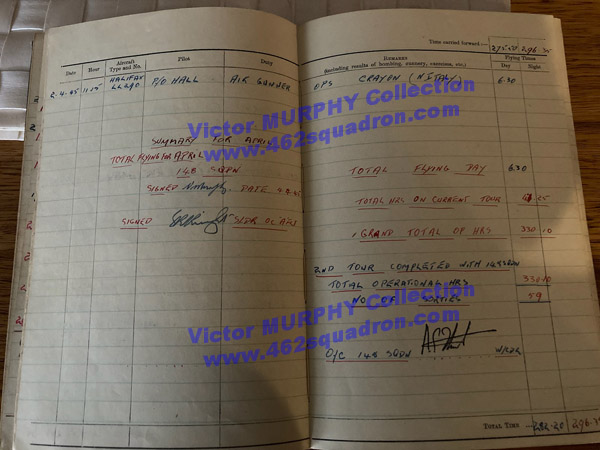
Photo from the Victor MURPHY Collection
Following in the A99301 Service File were multiple Postings which were difficult to decipher, with some dates clashing or repetitive – they may have been “on Paper” only, and not physically relocating from place to place.
14 Apr 1945 – Posted to 56 PTC (Personnel Transit Centre) Portici, near Naples, Italy, duties O T E (Operational Tour Expired)
24 (or 26) Apr 1945 – Posted to HQ ME Command, Middle East
27 Apr 1945 – Posted to 21 PTC, Kasfareet, Egypt
10 May 1945 – Embarked from Egypt, for UK (at 21 PTC)
24 May 1945 – Disembarked in UK (detached from MAAF)
24 May 1945 – Attached to RAF
24 May 1945 – Posted to 1 PDC (Personnel Despatch Centre) West Kirby, UK, for repatriation to Australia
11 Jun 1945 – “Repatriated to Australia from the Middle East (via the UK) for duty in accordance with RAF OHQ Repatriation Roll No. 25” (and underlined in red!)
15 Jun 1945 – Posted to 5 PDC, Padgate, UK
24 Jun 1945 – Embarked from UK, destination Australia
24 Jul 1945 – Disembarked at Sydney, Australia, ex Overseas
24 Jul 1945 – Detached from RAF (UK/Middle East)
24 Jul 1945 – Posted to 2 Personnel Depot (2 PD), Bradfield Park, Sydney, NSW
18 Sep 1945 – Discharged on demobilisation, from 2 PD; home address to Hanwood, via Griffith, NSW; 75 days payment in lieu of Leave (7 days Recreation Leave, 30 days Re-Establishment Leave and 38 days War Service Leave)
18 Sep 1945 – Clearance Certificate, covering various items, including issue of a “Hat and Suit Voucher”, and a Rail Warrant (to cover travel home?)
18 Sep 1945 – Advice to MURPHY, of his entitlement to Returned from Active Service Badge, to be forwarded as soon as possible
Oct 1945 – Issue of Airman’s Certificate of Service and Discharge (usual covering letter not in file)
08 Oct 1945 – Signed Receipt by W/O V MURPHY for RAAF Airman’s Certificate of Service and Discharge, home address Hanwood, via Griffith, NSW
30 Aug 1948 – Application for Aircrew in permanent RAAF, previous service from 24 Apr 1942 to 18 Sep 1945, as Air Gunner in UK, Middle east and Italy; home address Armadale, Melbourne, Vic; reference by Rev R O’DEA, of Griffith; occupation farming for 2 years prior to enlistment in RAAF, and 3 years since discharge; application just inside age cut-off of 25 years, and stamped as received by Air Registry on 01 Sep 1948. No further documentation, so unknown if Application was accepted or rejected. (Please refer to later section on Post-war life.)
27 Mar 1985 – Request by Dept of Veteran Affairs for Statement of RAAF War Service
17 Jun 1985 – File marked “Repat”
18 Jun 1985 – Statement of RAAF War Service
Medals – 1939/45 Star, Italy Star, Defence Medal, War Medal, Returned from Active Service Badge
Summary of flying hours – Completed at rank of W/O at 21 PTC – sub-sections were mathematically correct but total was not (type-written form, so possible transcription error from original hand-written version which was not in file; or missing data not included in the summary form).
Last page of log book was shown previously.
Aircraft Flown – from Log book – C.A.C. Trainer, Faery Battle (sic), Whitley, Halifax, Dakota, Wellington.
Training
1 BAGS, Aus, flying in Fairey Battle aircraft, 7 h 25 m;
10 O T U, UK, flying in Whitley aircraft, 35 h 20 m;
1658 C U, UK, flying in Halifax aircraft, 46 h 45 m
Total training – 89 h 30 m (correct)
Non-Operational Flying, on Squadron
Not itemised – 60 h 15 m
Total non-operational – 60 h 15 m (correct)
Operational Flying – First Tour from 14 Nov 1943 to 28 Nov 1944
462 Squadron, ME, flying in Halifax aircraft, Bombing, 14 Ops, 85 h 50 m;
614 Squadron, Italy, flying in Halifax aircraft, Target Marking, 10 Ops, 70 h 20 m;
148 Squadron, Italy, flying in Halifax aircraft, S/D (Special Duties), 24 Ops, 129 h 0 m;
Total First Tour – 48 Ops, 285 h 10 m (correct)
Operational Flying – Second Tour from 28 Nov 1944 to 02 Apr 1945
148 Squadron, Italy, flying in Halifax aircraft, S/D, 11 Ops, 45 h 0 m);
Total Second Tour – 11 Ops, 45 h 0 m (correct)
Total all flying – 59 Ops, 579 h 55 m (sic, possible data error for 479 h 55 m ?)
Character & Trade assessments
Under Training – Sgt – Character Very Good.
Operational Air Gunner – F/Sgt and W/O – Character Very Good; Proficiency and skill as Gunner Satisfactory; Ability as NCO Satisfactory
General Conduct Sheet – Not in file
Service Conduct Sheet – Certified No Entry as of 20 Jul 1945
"AUSSIE AIRMEN AID TITO" – PIX magazine (published by Associated Newspapers Ltd, Sydney) Vol 15, No. 13, dated 31 March 1945, page 30; available via Trove online (National Library of Australia)
Link to Trove article .... TROVE_image_TITO_Pix_pg30_web.pdf .....
Photos from the Australian War Memorial have been included in a previous section. Two of those photos were also published in the PIX magazine. The AWM captions refer to an “Australian Crew” from AWM – named in each photo is Victor MURPHY (of 462 Sqdn; later 614 Sqdn; later 37 Sqdn, and finally 148 Sqdn). The AWM captions identify the “Crew” as being from 614 Squadron, showing aircraft ‘C’ and “D” but no identifying squadron code. The interior photo names that aircraft as a Vickers Wellington, but that aircraft is more likely a Halifax, as seen in the other 3 photos. The same Australians are in the four photos, but checking Nominal Rolls and NAA service Files, the photos were more likely taken at 148 Squadron, Brindisi, not 614 Squadron, Celone. The same Nose Art in two of the photos would identify the aircraft and squadron. This was probably a Public Relations exercise, with photos and accompanying article specifically for the home newspapers, with the all-Australian crew selected or volunteered for the event. Rear Gunner Vic MURPHY certainly did not ever crew with the others named, and the article was the source of some amusement to him. If RAAF service files are available, postings could be compared for all of the "Crew". Comments or further information via contact.
WARTIME
RECOLLECTIONS of VICTOR MURPHY by Victor MURPHY, and prepared for Mrs Pat TALL.
Transcript of tape, March 1998; published as originally written (with minor spelling corrections), supplied by the MURPHY family, and used with their permission.
INTRODUCTION
I’m a little self-conscious of my efforts because, what I have come up with is as much about me and all our crew as it is about Pat. I guess that’s because for a short period in our lives our destinies were shared. When I was putting this together, I realised that my association with Pat lasted only about a year but it is often said that a week in politics is a long time. Similarly, a year was forever in the life of a bomber crew in 1943-44.
As you will hear, my recollections are mostly about the things that happened to us all together rather than as individuals. I don’t know how much of it, if any, will be new to you but I hope you will find it interesting and not only you but Neil and Alan, will accept it as a tribute to a fine man who became my friend and remained my friend even though, for many years, neither of us knew just what had become of the other.
TRAINING IN BRITAIN
I landed at Liverpool in early April, 1943, and was soon sent to Abbington in Berkshire for operational training. I joined Charles Hall’s air crew just as it was ready to move up to Rickhall in Yorkshire at the end of June, 1943. I was the sixth member of the crew, having joined as the mid-upper gunner, a crew member required on Halifaxes, the aircraft the crew was to train on for eventual posting to a Bomber Command squadron. At that stage, a flight engineer was required to complete the crew. Soon after our arrival in Rickhall, Charlie introduced us to a young man with a flashy smile who was to fill the vacancy. He was Pat Tall.
We were a fairly mixed bunch with our Scots pilot, Yorkshire navigator, Welsh bomb-aimer, wireless operator from Leicestershire, rear gunner and engineer from London and, of course, myself, all the way from Down Under, Australia. It didn’t take us long to get to know each other as is the way with young fellows, especially when thrown into the sort of circumstances in which we found ourselves.
Being newcomers, Pat and I seemed to pal up automatically, although we were all good friends from the start. I had a particular Australian mate who was in another crew and sharing the same hut as us. This fellow, Pat and I found ourselves spending quite a few of our evenings in the villages and towns around, sampling the various products on offer at the local pubs. Wartime beer in England was pretty weak and insipid and I can remember that, on one occasion, we felt that it really wasn’t giving us much of a lift. Pat came up with the bright idea that the beer would do more for you if you added a whiskey to it. Several pints, with whiskey, later, we ventured out into the street right into the paths of a couple of towering Service Police. Pat and my Australian friend, Dave, managed to keep out of trouble but, fortified as I was by the unaccustomed practice of mixing my drinks in the one glass, I must have given them more cheek than they were prepared to tolerate and so found myself under arrest. It all seems like a bit of a giggle now but I do remember feeling pretty much ashamed of myself next day, plus having a helluva headache. From then on I decided that English beer, weak and all as it might be, was better taken without additives.
Charlie, who was very straight-laced, and Harry, the only married member of the crew, did not join us on our pub crawls, while George, Taff and Phil Williams usually went out together. Pat, Dave and I spent a fair bit of our spare time together during that month that we were at Rickhall.
POSTING AND LEAVE
At the end of the month, conversion of the crew was complete and postings were made to various bomber squadrons operating all around Yorkshire. It was a complete surprise to us to find that we had been posted to the Middle East, along with one other crew on the same conversion course. This was good news for us, although I had some mixed feelings because my friend, Dave, was in a crew posted to Bomber Command. We were good buddies and I was a bit sad at being separated from him. On the other hand, our prospects of surviving the war took a decided uplift by the Middle East posting.
We were duly sent on leave prior to going down to Swinden to pick up an aircraft which had to be prepared for the flight to Africa. I really didn’t have any particular place to go on leave while all the other fellows were going home to their families for a few days. Realising this, Phil Williams, the rear gunner, invited me to spend the time with he and his parents in London. When we were almost due to head for Wiltshire, Phil received a telegram ordering him to return to Yorkshire. We couldn’t understand why I wasn’t similarly recalled and so we sent a telegram up to Rickhall asking if I should also return. The answer was, “No”. It turned out that the Halifaxes we were required to fly in the Middle East were not equipped with a mid-upper turret and therefore no mid-upper gunner was required. As this was my position in the crew, it remains a mystery to me to this day why I was not recalled.
Phil went back to join a Bomber Command squadron. Years after the war was over I started to wonder whether he managed to get through a tour of operations but found it very difficult to get any accurate information as, without knowing his service number, the Air Ministry could not find his records. However, Charlie was able to ascertain that a Warrant Officer P. Williams was shot down over Berlin in December, 1943, and was repatriated to Britain in 1945. I sincerely hope that it was him.
FINAL PREPARATIONS
The rest of us assembled in Wiltshire in due course. It was getting into September by this time and the weather was becoming a little less reliable for flying. The aircraft which we were to take had to be air-tested, consumption-tested and packed with all sorts of junk which was apparently required on a squadron. The aerodrome we were on was actually situated at Lyneham, some few miles from Swinden. While we were still there, my friend, Dave, got leave from the squadron. He, like me, was the only Australian in his crew. He took the opportunity to come down and visit us during his leave. By this time, he had already completed about six or seven bombing operations while we were still messing about with our preparations to go south. When he came down, we celebrated our reunion in the usual manner. He, Pat and I went on a pub crawl in Swinden. I know I was glad to see him and also a little envious of the fact that he was getting to be something of a veteran while we were still waiting to see our first flak burst. Apparently, as the night wore on and the alcohol drove away my inhibitions, I must have gone a little overboard in expressing my joy at seeing him again, alive and well. At least it got on Pat’s nerves because he reminded me more than once that he got sick of me repeating my claim to be glad to see my mate.
LYNEHAM
The unit at Lyneham was a little more up-market than some we had been on previously. It even ran to actual bath-tubs that one could soak in. Unfortunately, they were not very private and I can remember some of us, Charlie, Harry and I, I think, walking past a bathroom one time. We looked through a hole where a window should have been and there, luxuriating in a great tub-full of water was Pat. We didn’t see anything unusual in a fellow taking a bath but he did cop a fair bit of ribbing when we noticed that he was happily washing a couple of pairs of his socks at the same time in the same water.
Eventually, we were ready to go. On 21st September, 1943, we flew down to Herne from where we set out for Rabat-Sali, in French Morocco. Departure time was 3:15 a.m. so that we could be across the Bay of Biscay before daylight arrived to make us an easier target for any prowling enemy who might be about. I remember that breakfast served about 1:00 a.m. was a particularly greasy dish which may or may not have been the reason that I was airsick for the first and only time during that flight. After about nine hours of flying, Rabat-Sali finally came into sight. We were doing a circuit of the aerodrome as part of the landing procedure when I noticed black smoke streaming past my position in the rear turret. At the same time, I could hear Pat’s voice on the intercom, with more than a hint of urgency, telling Charlie to feather the port outer engine. This was done, an extra circuit completed, and we landed under the power of the three remaining engines.
RABAT-SALI
Once on the ground, we were really surprised at the difference in temperature compared with that of the England we had just left. The next day, after a rest, we broke out our shorts and shirts, for me the first time since leaving Australia and, for the British lads, probably for the first time in their service careers. The barracks that we occupied looked as if they had been built for the French Foreign Legion. The toilets were unlike anything any of us had seen before, with just a couple of foot plates by a hole in the floor?no seat. We thought that they were quite funny and Harry insisted on claiming that he was off to do a Gordon Richards whenever he had to answer a call of nature. I guess I don’t need to say that Gordon Richards was a great English jockey of the time. Well we might laugh at these facilities, but they were luxurious compared with the spartan amenities which lay in wait for us at our more permanent stations.
BACK TO BRITAIN
We soon learned that the damaged engine on our aircraft could not be repaired in time for us to take it on further. Consequently, we had to return to Britain to pick up another. The return flight had to be made on a B.O.A.C. Dakota. While awaiting such a flight, we had an opportunity to look around Rabat-Sali and had our first contact with a predominantly Arab society. During that time also we found out that Pat had a real problem with his feet. It hadn’t been noticeable in the cooler climate of England, but, in the African climate, his tendency to perspire more than the average and his disinclination to change his socks regularly combined to make he and his footwear unpleasant company within the confines of a small billet occupied by six people. Needless to say, he received plenty of advice as to why and how he should improve his personal hygiene.
The flight back to Britain by B.O.A.C. proved to be fairly eventful. At our first attempt, we left Rabat-Sali under cover of darkness one night, flew for many hours and finally landed back at an American naval base, Port Leoti, only a few miles north of our starting point. It seemed that the pilot had decided that headwinds were going to prevent him from reaching home with the fuel he had and turning back was his only option. We tried again the next evening, but this time the radio compass on the aircraft failed and morning found us wandering down the eastern coast of Spain. We had apparently meandered across the very mountainous Iberian peninsula without the pilot and his co-pilot realising what was happening. We were grateful to see two Spitfires appear, position themselves, one at each wingtip, and guide the Dakota into Gibraltar.
GIBRALTAR
We were a week on Gibraltar, waiting for the right weather to make our third and final attempt to return to Britain. The Rock was an interesting place, stuck like it is like a pimple on the pumpkin of Spain. There was an abundance of fresh fruit available in the shops. I hadn’t seen this sort of produce since leaving Australia some seven or eight months earlier but the British crew members had been living in a fruit-free society since the outbreak of war, three years back. When we eventually headed north again, they were all laden with as many bananas as they could carry back to their families. We were all amused later to hear Harry tell how he had got into a conversation with a woman on a train ride to his home after our return. The woman had a child of about five or six with her. She was telling Harry that the little one had never seen a banana. Harry surprised the life out of her by handing the kid a banana and saying, “Well, he has now.”
Back to Lyneham where the whole process of getting an aircraft ready for Rabat was repeated. It was, of course, getting closer and closer to winter and the weather was getting steadily worse. It was not until the 6th of November that we again headed to North Africa.
Once again we landed at Gibraltar, an unscheduled stopover which, I think, Harry engineered so that he could get more bananas. I remember that the Commanding Officer was not very pleased to see us and asked some hard questions as to why we were so far off track. The pilot and navigator had to come up with the answers, which they must have done satisfactorily since nobody was court-martialled. (Joke!)
RABAT-SALI AGAIN
From Gibraltar, we flew the short distance to Rabat. From there we headed east to join our squadron at Birka, near Benghazi, which we reached on the 14th of November, 1943. This was something of an eye-opener. Of course we didn’t expect three star accommodation but it came as something of a shock when the Quarter-Master Sergeant led us to a tent which was big enough for four people at a pinch and told us that that would be home for the six of us. He managed to produce a few blankets for each of us but there was nothing to go between them and the sand on which the floorless tent stood. I am still amazed that we six were crammed into such a small space. I think the squadron had a policy of one tent per crew but we were unusual as we were, at that time, all non-commissioned. Most crews had an officer or two who, naturally, had to be housed separately from their inferiors thus reducing the over-crowding to some extent of crews composed of both officers and non-commissioned ranks.
The cramped conditions we could put up with but the idea of sleeping on the ground did not appeal. Fortunately, we were soon sent to Benghazi to bring back an aircraft. While there, someone sighted a group of ambulance stretchers standing unguarded. Six of these went quickly into the aeroplane and, when mounted, each four-gallon jerry cans, made reasonably comfortable beds. When we ultimately moved over to Whitley, these stretchers were among the first of our possessions to be packed into the aeroplane.
FIRST ATTEMPT AT AN OPERATION
Soon after our arrival at the squadron, No. 462, which was officially an Australian unit, although most of the air crew and a fair percentage of the ground crew were not, we were preparing for what would be our first real operation as an aircrew. Take-off time was to be soon after dark and most of the night was to be spent in the air. We were all feeling a little nervous in anticipation of our first confrontation with enemy defences and had decided to rest up in the tent during the afternoon. While we were all trying to relax on our stretchers, a mighty explosion shattered the siesta atmosphere. We were all on our feet in an instant, rushed outside to see a great pall of smoke curling into the air from the direction of the aircraft dispersal area. There was speculation amongst us as to what might have happened. Either the fuel or the bomb dump going up were the most favoured guesses. But, in fact, an unfortunate accident during bombing-up of one of the Halifaxes had been responsible for the big bang. The armourers had apparently accidentally triggered one of fifteen 500lb bombs which were to be loaded onto the aircraft. This had set off the other fourteen, resulting in a tremendous explosion which, not only blew the Halifax to smithereens but took the lives of eleven men who were working on it at the time. Only a roll call of the entire personnel of the squadron could ascertain the actual number of the missing. Operations were called off for that night.
SECOND ATTEMPT
We didn’t get off the ground at our next attempt to carry out a bombing operation but, at least this time, we got as far as the runway. When it came our turn to take off, we charged down the sandy strip which served as a runway and which ran through a boulder-strewn piece of desert. About halfway down the strip, with the engines screaming at full power, the Halifax took a violent swing to one side. Charlie aborted the takeoff and he and Pat had a conference as to what might have been the cause of the problem. They knew that power had fallen away very suddenly in either one or two of the engines on one side but, as all the motors were ticking over quite nicely at minimum throttle, it was decided to go try again. The next attempt brought an exactly similar result and, as we taxied back to the end of the runway, I can remember the flight commander who had been watching proceedings, rushing pantingly up to ensure that there was no third attempt to get off the ground. I guess he had visions of the explosion of a few days before and could see similar possibilities for us if the swing had taken us off the runway into the boulders or the undercarriage had collapsed under the strain of the violent change in direction. Subsequent investigation by ground crew found that two engines were not getting properly supplied with fuel at full throttle but behaved normally at lower levels of power. When this problem was fixed the aircraft had to be taken into the air and the bombs jettisoned into the sea. They could not be safely removed otherwise.
THE REAL THING
On 5th of December, 1943, we finally launched on our first hostile foray against the enemy. The target was the railway station at Salonika, in northern Greece. Unfortunately, the Greeks were not our real enemy but I guess the fact that the country was occupied by Germans who used its ports and roads for war supplies justified our actions. Salonika was not heavily defended and I can remember the light flak tracers curling up towards us but not quite reaching our height and thinking that this was a piece of cake. I think the other crew members were feeling quite self-satisfied and quite relieved when we headed back for base. Our smugness was soon eroded, however, when we inadvertantly flew smack over a German aerodrome defended with radar-directed 88mm anti-aircraft guns. The shells that burst under and all around us gave us a minute or two to remember for the rest of our lives. They came without warning, no searchlight or tracer shells, but I can remember Harry’s voice on the intercom exhorting Charlie to, “Weave! Weave like hell!” And Charlie’s calm voice in reply saying, “I am weaving Harry. If you don’t believe me, come up and look at this turn and bank indicator.”
We negotiated quite a bit of flak in subsequent operations but we were never again as shocked and surprised when we felt it crunch around us.
CHRISTMAS, 1943
We completed another four bombing operations to Greece, including the island of Crete before Christmas. At Christmas time we were told that the squadron would stand down for a few days. Celebrations were in order and it was then that we who were partial to the odd alcoholic beverage decided that we would try to get our teetotal pilot to let his hair down. Charlie agreed to visit the mess with us and was convivial enough to share a couple of drinks. But he soon woke up to the plan to get him under the weather. Pat, in particular, tried to outsmart him by getting the barman to concoct a mixture of just about every poison in the bar. He then tried to palm it off to Charlie as something innocuous but really he had no hope of getting him to drink it. Since Charlie wouldn’t partake of this lethal brew, the rest of us decided that it was too good to waste and that we should share it. In the final outcome, Charlie had five crew members to drag back to our tent, and also, some time later, had to help Harry find his false teeth, lost among the sands of the desert.
The next day dawned on some sore heads and sorry airmen who were in no way cheered to learn that the promised stand-down had been abbreviated to the extent that we were to fly that night, 26th of December. We were all thankful, I’m sure, that our devious plans for Charlie’s Christmas cheer hadn’t worked and that he, at least, was, as usual, clear-headed and capable when we set off to Piraeus Harbour, Athens, with our customary load of death-dealing high explosives.
LEAVE IN ALEX
On 28th of December, we were able to get to the Nile delta for a short spell of leave. The squadron used to send its aircraft to Cairo West for regular maintenance and, by sending two crews, with each plane was able to give everyone a chance to spend a little time in Cairo or Alexandria or both.
The way I remember it, Charlie and Harry spent their time in Cairo, looked at the pyramids and otherwise took in some of the history of the place. The rest of us headed for Alexandria. I can remember seeing the pyramids from the back of a truck as we hitch-hiked past. I still regret the lost opportunity to take a closer look at these mysterious and wonderful monuments to an age long gone, but, at that time, Alexandria seemed to have more to offer to the impetuous, youthful pleasure-seekers. We stayed at Beaufighter House, run by the RAF with civilian staff. Apart from a swim or two at the beach and consumption of more than our share of Egyptian beer, there was nothing very special about our holiday in Alex. We were in the residence over the New Year, however, and the management put on a bit of a party to which young civilian ladies and their chaperones were invited. Among my souvenirs, I still have a photograph of Pat and Ken Potts, the Australian pilot of the other crew who accompanied us on leave, taken at that function which, by their silly grins, gives every indication that they were having a wonderful time.
EL ADAM
Soon after Christmas, the squadron moved to El Adam, near Tobruk, where we were afforded the luxury of two tents between the six of us. The aerodrome was literally covered in pieces of shrapnel as a stark reminder of the many months of siege endured by the garrison there. The town of Tobruk, only a short distance away, was a shambles, with hardly a building intact. There was a lot of old 9mm ammunition lying about. Someone had found out that, although it was not quite the same calibre as our .38 Smith and Wesson handguns, it could be fired from these weapons at a pinch. Consequently, we used to wander some distance away from our camp and spend hours shooting at some of the thousands of empty bottles which lay around. We were usually accompanied on these jaunts by a young Scot named Bill McKay. Bill was engineer in a crew captained by an Australian pilot named Gerry Attwell. Bill and Pat had been friends prior to Pat’s joining our crew in Rickhall. Very often Bill could be found in our tent having a yarn. He seemed to spend more of his spare time at our place than with his own crew mates.
SAND, SAND, SAND.
While at El Adam, we experienced a real sandstorm for the first time. Our tents had been pitched on rocky ground so hard that it was impossible to drive tent pegs in. We had overcome this difficulty with the brilliant scheme of using rocks to anchour the guy ropes, in lieu of pegs. When the wind got up, the ropes rubbing against the rocks frayed through and the tents collapsed and we were homeless. There was no way of re-erecting them while the wind was blowing so we took shelter in the NAAFI Nissen hut, that being one of very few actual buildings on the station, and played cards until the storm blew itself out. I had seen a few dust storms where I grew up in south-western New South Wales but nothing to compare for ferocity and intensity with this North African example. When the wind finally dropped, we were able to hoist our tents again but found sand in everything we owned. I had a suitcase which, although locked, still filled with sand.
RAIN, RAIN, RAIN.
Shortly after the sandstorm, we saw torrential rain. Up until this time we had been four months in North Africa without a drop of moisture from the sky. But, when it did come down, it poured. I think Charlie, Pat and I were in one tent, while Harry, George and Taff occupied the neighbouring one. Ours was on slightly higher ground than theirs which started to flood while ours remained above the water-line. While Harry and the others were out in the rain, trying to dig a drain around their threatened abode in that hard rocky ground, Pat and I were inside our dry quarters, poking fun at them. Harry was not amused and told us so in no uncertain terms. I guess we should have helped but, at the time, preferred to enjoy their misery.
STORM OVER PIRAEUS
In the meantime, weather permitting, our excursions up to Greece continued. On 15 January, 1944, we set off for Piraeus on a night when the weather threatened. After a couple of hours of flying, we were ploughing through some towering cumulo-nimbus clouds. Static electricity was forming haloes of light around every protrusion on the aircraft, including my four machine guns, and ice was forming on the leading edges of the wings. Charlie was complaining that he couldn’t get the height he wanted despite his best efforts. The outside temperature was -26? Celsius and there was no heating back in the turret where I travelled. We could all feel that the plane was wallowing and were all wondering why we had been sent out in such conditions. Finally, Pat’s voice over the intercom could be heard urging Charlie to drop the eggs. He obviously sensed that the aeroplane was in danger of going into a stall. Charlie was never one to give up easily but, after some thought, he decided to accept this very sound advice and ordered Taff to jettison the bomb load. Thereafter, we descended to a few feet above the sea level and headed for home under considerably smoother and warmer conditions than we had experienced up among the clouds.
There was some apprehension about how our aborted mission would be viewed by the authorities on our return. But there was no need to worry. A general recall had been sent out but not picked up by George, no doubt because of all the electrical interference generated by the storm. One other crew had missed this message and somehow managed to fight on to the target and perform a single bomber air raid without realising that none of its companions had come to share the offerings of the ack-ack gunners.
MOVE TO ITALY
One more attack on Piraeus Harbour and we were ready to move across to Italy. This happened on 1st March, 1944, by which time the Italian winter was supposed to be over and operating conditions suitable for our bombers. It was still cold and wet, however, when we landed at Foggia in a Halifax laden with all sorts of bits and pieces by way of personal belongings, which must have looked pretty scrappy to the Americans who watched us unload but which, by dint of experience, we were not prepared to part with until absolutely sure that something better was available. As it was, we needed everything we brought, including our beloved stretchers.
Italy was beautifully green after the uninviting brown of North Africa. We still lived in tents but, on this occasion, joined our two tents together as one big one. This obviated the need to decide how we should split up into two separate groups but did cause a few complaints from the administration wallahs who could not find an ordinance which authorised the joining of two tents. These objections we managed to ignore and lived happily for some weeks in our canvas duplex.
On 11th of March, 1944, we were sent with a load of bombs for targets in northern Italy. This exercise was quite uneventful until, on our return to base, Harry plotted a course which would shorten the journey and save our diminishing fuel supply. Unfortunately, the track chosen took us right over the Anzio beach-head where the Germans were still containing the Allied landing there. The anti-aircraft fire which suddenly burst all around us was the fiercest and most accurate that we had so far encountered. It is still not clear whether the guns belonged to our enemies or our friends or whether it was a combination of both. At any rate, it was made abundantly clear to us that we were not welcome in that area at that time. The few minutes that it took to fly out of the danger area seemed to take hours. When we finally reached the ground, the aircraft showed plenty of evidence of the accuracy of the gunners and, once again, we could see how luck had been on our side.
OLIVE, OLIVE-OH!
Our first station in Italy was very close to the city of Foggia, a city in one of the few pieces of flat land in the whole country. After a month or two, we moved to another aerodrome? still on the Foggia plain? but this time we were camped in the middle of an olive grove. It was getting right into summer by this time and the beautiful, balmy weather made for a feeling of peace, tranquillity and easy living in our shady camp, watching farm workers pick up the fallen olives.
There was still a war going on, however, and the word went out that aircrew should try to keep physically fit, particularly in view of the very rough country we might be required to walk over should we be unlucky enough to need to abandon our aircraft in the mountainous terrain over which we normally operated.
Charlie was enthusiastic about the idea of getting a bit of exercise and soon all of us were following him on quite a few hikes into the surrounding hills; that is, all of us except Pat who argued that we would wear ourselves out that way and that he would preserve his energy for use in the event of an emergency. When we returned from many of these hikes, we would invariably chiack Pat about the spine-bashing he had done while we were churning up the calories. But, he was never phased, told us how much of his book he had read in our absence and how he was accumulating great reserves of energy while we were wasting ours.
PAT’S MATE, BILL
Operations against targets in northern Italy, Bulgaria, Germany? that is, Munich? Romania and Hungary continued until the end of June, 1944. Each of these destinations was more heavily defended than those we had attacked in Greece but our luck continued to hold. The same was not true for Pat’s friend, Bill McKay. Bill, together with his crewmates, had not returned from one of their sorties. About eight days after their disappearance, the six young men were washed up on the Adriatic shore of Italy in a rubber dinghy. They had all perished from exposure, thirst and starvation. The weather had been terrible during the time they had been at sea. As Bill’s best friend, Pat was asked to identify his body. This was something that an operational aircrew member should never be asked to do. I remember how shocked and affected by the experience Pat was. I’m sure he was not prepared for the terrible ravages on his friend’s appearance wrought by the exposure to the weather and the sea.
PAT LEAVES US
I cannot say for sure, but it seems no coincidence that Pat became ill shortly after this ordeal. He was stricken with pleurisy, which may or may not have been the result of the severe shock he had endured. His illness brought about his hospitalisation for a period, which meant that he had to be replaced in our crew. Pat went to Naples for his recuperation while we, with our new engineer, Jim Leeming, went south to Brindisi, where we joined a supply dropping squadron.
THEN AND NOW
Pat and I had a very brief exchange of letters after he was sent off to hospital but, in the way of young people living one day at a time, as we did during those turbulent times, we simply lost touch after that.
It was more than 40 years before we were in contact again and before I found that he had joined Transport Command after recovering from his illness. During those 40 odd years I had thought of Pat and all my crewmates very often. When I met Pat in 1990, despite the lapse of time, despite the fact that he was obviously very seriously ill, I had not the slightest trouble in recognising him and, in fact, could have picked him out of a crowd anywhere. Furthermore, the old wit and humour were still the same. The personality seemed hardly to have changed at all. I will always be thankful for that chance to meet again and also for the correspondence prior to that meeting which provided the answer to one question which had always lingered in my mind, “I wonder what happened to Pat.”
................... End of Wartime Recollections by Victor MURPHY
Post-war Biography for Victor MURPHY, as supplied by his son, and used with permission.
Rear-gunner Victor Murphy was 21 years old when the war ended. Upon his repatriation, he returned to the family farm in Hanwood, outside Griffith, NSW, where he used the money saved from his wartime service to try to revitalise his aging father’s orange orchard. In that he was unsuccessful and so he went on to a series of jobs before moving to Melbourne where he worked for the Postmaster-General’s department. It was here he met Theresa Roche and they married on 6th September 1952. For a time Victor worked for the Department of Civil Aviation while he undertook night study in accounting and eventually moved to the Taxation Department where he worked until his retirement in 1976. Victor and Theresa were married for 56 years. They had three children and six grand-children. They led steady and peaceful lives together in and around the Melbourne suburb of Watsonia, enjoying tennis and golf in their spare time. In 1977 Victor and Theresa travelled to Britain and it was on this trip Vic was reunited with his wartime pilot Charlie Hall with whom he had lost contact for over 20 years. Charlie was able to re-connect most members of the crew, on this and a subsequent visit. That was a wonderful experience for him. He said often that the bond formed by a wartime aircrew was unbreakable. Victor passed away peacefully at the age of 84 on 14th September 2008.
If you can assist with further information or photos of Victor MURPHY, please make contact.
Return to top
Other Crew members, and Air Force personnel in photos shown in previous section – information to be added
Original Rear Gunner: Phil WILLIAMS
Replacement Flight Engineer: Jim LEEMING
Flight Engineer William McKAY of ATWELL Crew
F/Eng Bill McKAY in El Adem photos – names for Pilot Gerald Joseph ATWELL 411673 RAAF, and A/G Leonard Henry HIBBINS 414681 RAAF were listed in Jan 1944 POR for RAAF personnel: they had departed from the UK on 13 Jan 44; arrived Egypt 24 Jan 1944; arrived at 462 Sqdn on 27 Jan 1944; but not located in 462 Sqdn ORB Ops.
Later transferred to Italy with 462 Squadron, then posted to newly named 614 Squadron.
20/21 Apr 1944 – ATWELL Crew FTR – including Pilot ATWELL 411673 and F/Eng Sgt W C McKAY 1569125 (sic), and others, in Halifax JP108); all KIA.
CWGC – Death dates listed as 20/04/44
ATWELL, Gerald Joseph 411673 KIA 20 April 1944 age 27 Malta Memorial Panel 16; Column 1
Crew – ATWELL (RAAF), MacLEOD (RNZAF), JONES (RAFVR), McKAY (RAFVR), HIBBINS (RAAF), PRIME (RAFVR)
(Sce Number errors in 614 Squadron ORB when compared with CWGC)
SMALL – Addition to crew at 148 Squadron, Phil SMALL, from New Zealand, as dispatcher for packages and supplies being dropped to partisans; and dropping Nickels (leaflets).
From Auckland War Memorial Online Cenotaph – Philip Henry SMALL, 427863 RNZAF, born 08 Dec 1922; died 24 Apr 2012; last rank as Flying Officer, last posting 148 Sqdn (Special Duties) Italy; Cenotaph portrait photo matches facial features of previously unidentified crew member with Halifax LL290; F/Sgt P H SMALL named in ORB on that Op
Wing Commander D G HAYWARD of 614 Squadron and 148 Squadron
From 148 Sqdn ORB Form 540, Aug 1944
22 Aug – Postings To Sqdn – Officers – S/Ldr D G HAYWARD, from 614 Sqdn (He was on Ops at 614 Sqdn at the same time as Charlie HALL's Crew, so the friendly faces in the crew photo are not surprising.)
28 Aug – S/Ldr D G HAYWARD assumed control of 148 Squadron
28 Aug – F/L (A/S/L) D G HAYWARD granted the rank of Acting Wing Commander
16 Mar 1945 – London Gazette, Immediate Award of DSO to W/Cdr D G HAYWARD (42565)
21 Mar 1945 – F/L (A/W/Cdr) D G HAYWARD (42535) posted to H Q RAF ME
Return to top
Crew Ops at 462 Squadron
Op Number relates to Ops for Pilot Charlie HALL, who carried out 13 Ops at 462 Squadron. The usual crew was made up of those listed in previous sections, with no substitutions. Each crew member each carried out 12 Ops with HALL. All care has been taken in transcribing the data, however legibility of the original ORB was a problem, so errors may have occurred.
Ops in November and December 1943 were flown from the base at Terria,near Benghazi.
Ops in January and February 1944 were flown from El Adem, near Tobruk.
| Date |
Op No |
A/C Serial |
Up |
Down |
Target |
Comments |
| 18/11/1943 |
1 |
BB386 |
0035 |
0714 |
Khalkis, Greece |
Night of 18/19 Nov;
Sgt HALL as 2nd Pilot for R H V THOMAS and Crew; 3 bombing runs over target; aircraft fired upon by flak during each bombing run; poor weather, visibility hazy. |
05/12/1943 |
2 |
JN890 |
1730 |
0128 |
Salonika, Greece |
Night of 05/06 Dec; First Op by HALL with usual crew;
returned with flak hole in nose perspex. |
| 06/12/1943 |
3 |
JN890 |
1830 |
0100 |
Salamis, Greece – flak and search light positions |
Night of 06/07 Dec |
| 08/12/1943 |
4 |
JN890 |
1745 |
2345 |
Candia, Crete |
After leaving target, observed one unidentified twin-engine aircraft flying towards Candia, but no contact made. |
| 12/12/1943 |
5 |
BB382 |
1816 |
2337 |
Suda Bay shipping, Crete |
- |
| 19/12/1943 |
6 |
BB331 |
2345 |
0700 |
Salamis, Greece – flak and search light positions |
Night of 19/20 Dec; coned in searchlights west of Piraeus. |
| 26/12/1943 |
7 |
JN890 |
2115 |
0405 |
Piraeus, Greece – docks and shipping |
Night of 26/27 Dec; visibility poor, bombs dropped through patch in cloud |
| 11/01/1944 |
8 |
JN890 |
1835 |
0046 |
Piraeus, Greece – harbour installations |
Night of 11/12 Jan; Coned by Master searchlight at commencement of bombing run, and until bombs released. |
| 15/01/1944 |
9 |
JN890 |
2237 |
0514 |
Piraeus, Greece – harbour installations |
Night of 15/16 Jan; Op abandoned, due to severe icing and weather conditions; unable to climb above 14,000 ft due to 10/10 cloud cover; bombs jettisoned; diverted to to LG07 on return (Matruh West) |
| 22/01/1944 |
10 |
JN890 |
1741 |
2355 |
Piraeus, Greece |
- |
| 23/01/1944 |
11 |
JN890 |
2350 |
0030 |
Piraeus, Greece – harbour installations |
Night of 23/24 Jan; early return due to port outer engine failure; bombs jettisoned |
| 01/02/1944 |
12 |
JN890 |
1839 |
2248 |
Suda Bay, Crete – Diversionary bombing |
- |
| 09/02/1944 |
13 |
? |
1744 |
2210 |
Candia Harbour, Crete – Diversionary bombing |
Two crews recorded in ORB for same aircraft BB446 –
Pilot CM HALL, and Pilot DALTON; log book for MURPHY records HALL crew in JN890; one enemy aircraft sighted at 10,000 ft but no contact made. |
Two early returns – one due to engine failure, and one due to severe icing and weather conditions.
Aircraft were Halifax Mk II. The aircraft code was not usually recorded on the Form 541.
However from other sources BB382-B and BB446-T moved to Italy with 462 Squadron, later flying with 614 Squadron.
The Charlie HALL crew flew 9, possibly 10 of their Ops in Halifax JN890.
They also flew JN890 from El Adem to Celone, Italy on 01 March 1944.
Return to top
|
| |
|
Honours and Awards
Distinguished Flying Cross – Pilot HALL
London Gazette Issue 36954, Friday 23 Feb 1945, page 1071 ………
Air Ministry, 23rd February, 1945.
The KING has been graciously pleased to approve the following awards:- …..
Distinguished Flying Cross. ….
Warrant Officer …..
Charles Mortimer HALL (1349894), R.A.F.V.R., 148 Sqn.
No citation for DFC located.
Polish Cross of Valour – Pilot HALL
AIR-27-996-17 – 148 Squadron ORB, Form 540, Sep 1944, page 4 (19 september 1944)
Decorations
The following awards for gallantry in flying operations on this Unit were approved by His Majesty the King:
DFC ......
DFM .....
Polish Cross of Valour – F/Sgt C M HALL (1349894) ........ (and five others named)
Polish Cross of Merit .....
Award would have been promulgated in London Gazette, but has not been located for HALL. However other recipients of Polish Crosses were listed, with the following text ..... "Conferred by the President of the Republic of Poland" and "The King has granted unrestricted permission for the wearing of the undermentioned decorations conferred upon the personnel indicated in recognition of valuable services rendered in connection with the war". One might assume that HALL's Cross of Valour was for the same or similar reason.
Green Endorsement in log Book – Pilot Hall
148 squadron, 12 Aug 1944 – BB196 Pilot W/O HALL carried out a forced landing at Lecce due to fuel shortage; successfully landed in small field without collision with stone wall
Return to top
 to Squadron Crews Middle East to Squadron Crews Middle East
|
|
|
|
|
|
|
|
|
|
























